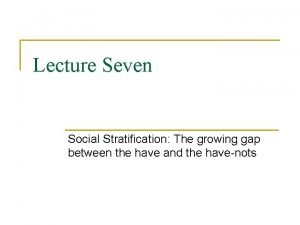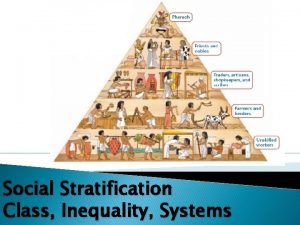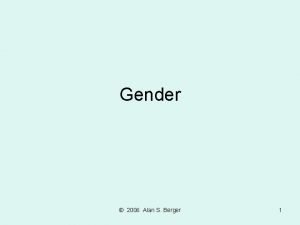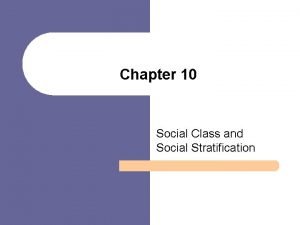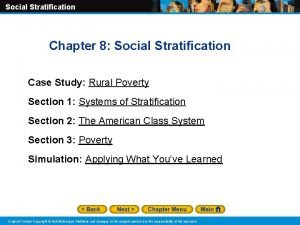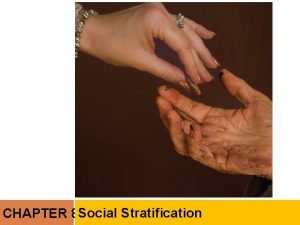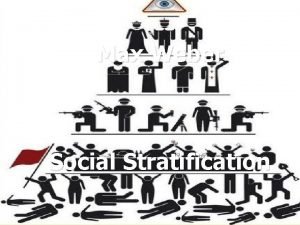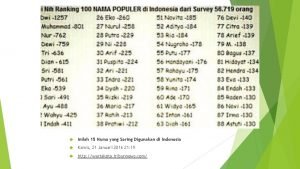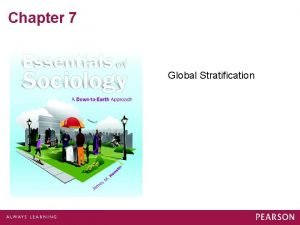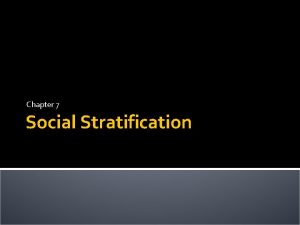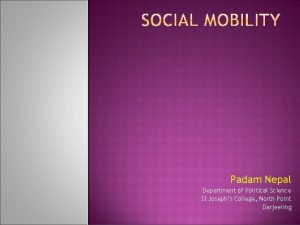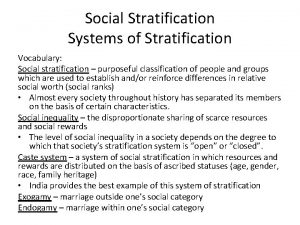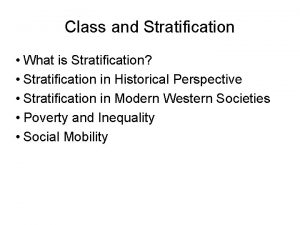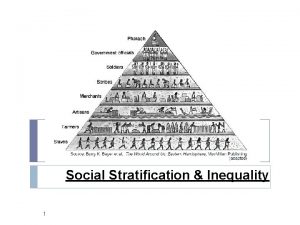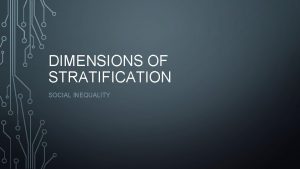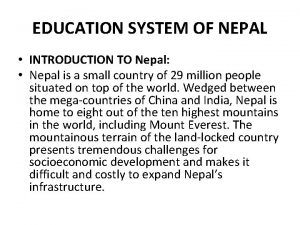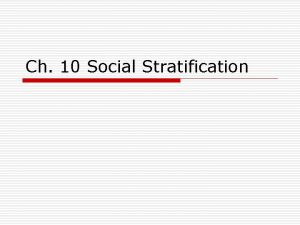SOCIAL STRATIFICATION Dr Padam Nepal Department of Political





















- Slides: 21

SOCIAL STRATIFICATION Dr Padam Nepal Department of Political Science St Joseph’s College, North Point Darjeeling

INTRODUCTION q Social inequality is a perennial problem, and therefore, it is found universally in one form or the other. q Such a conception of the social inequality, built on the distribution of property, wealth, honour and power among individual members, would imply a certain ideological basis and a structural arrangement of the people based upon those inegalitarian institutionalized norms q This produces social stratification

DEFINITIONS q. Raymond Murray: “Social stratification is a horizontal division of society in to higher and lower social units”. q. Gisbert: “Social stratification is the division of society into permanent groups or categories linked with each other by the relationship of superiority and subordination”. q. Williams: “…the ranking of individuals on a scale of superiority, equality according to some commonly accepted basis of valuation”.

DEFINITIONS q. Sorokin: “ it is manifested in the existences of upper and lower social layer. Its basis and very essence consists in an unequal distribution of rights and privileges duties and responsibilities, social values and privations, social power and influences among the members of a society. ” q. Lundberg : “a stratified society is one marked by inequality, by differences among people that are accepted by them as being ‘lower’ and ‘higher’. Thus, it is clear that social inequality is the basis of social stratification. q. Melvin Tumin : “an arrangement of any social group or society into a hierarchy of positions that are unequal with regard to power, property, social evaluation and psychic gratification”.

MEANINGS…. It is the ranking of the groups of people in a society, which is related to the differences in access to resources & life chances in a society. Society can be seen as consisting of strata, in a hierarchy, with the more favored at the top & the less privileged nearer the bottom.

FEATURES Firstly, Social stratification is ‘social’ as it does not represent biologically caused inequalities. Secondly, the practice of social stratification is rooted in antiquity. Thirdly, and most importantly, the concept of social stratification is characterized by universality. All societies in the world are stratified, although differently, based on different bases. It is in this connection that Sorokin once observed: “All permanently organized societies are stratified”. Fourthly, the rankings apply to social categories of people who share a common characteristic without necessarily interacting or identifying with one another. Fifthly, people’s life experiences & opportunities depend heavily on how their social category is ranked. Finally, The ranks of different social categories tend to change very slowly overtime.

BASES q. CASTE q. CLASS q. POWER q. STATUS q. ESTATES q. SLAVERY q. GENDER q. RELIGION ETC

CLASS as a Base of Stratification It is a large scale grouping of people, who share common economic resources, which strongly influence the type o lifestyle they are able to lead. It is an economic stratification system, as the ranks of people determine their access to higher education, high paying jobs. & premium health care. Therefore, ownership of wealth & occupation are chief basis of class difference. Karl Marx viewed class differentiation as the crucial determinant of social, economic & political inequality. His main focus was on the effects of class on all aspects of the 19 th century Europe. According to Marx, people have false consciousness (an attitude that doesn’t reflect its objective position). A worker with false consciousness may feel that he is being treated fairly by his boss. He felt that a revolution is possible only if people replace the false consciousness with class consciousness (a subjective awareness held by members of a class about the need for collective action to bring about social change).

Max Weber: Class & Stratification Max Weber insisted that no single characteristic (such as class) totally defines a person’s position in the stratification system. He identified 3 components of stratification” ◦ Class: refers to people having similar level of wealth & income ◦ Status: refers to people having similar prestige or lifestyle. ◦ Power: ability to exercise one’s will over others.

Power as a Base of Stratification According to Max Weber, the basis of social stratification is the unequal power of the society in an organized way. Power in the society is not equally divided among all its members. It is on the basis of the division of power that some become high and others become low, and those who enjoy more powers become superior to others. Thus, according to Weber, the basis of social stratification is power, which may be economic power, political power, or social power.

ESTATE AS A BASE OF STRATIFICATION Estates may be defined as a political group; it is an organized collection of several orders, estates or conditions of man who are recognized as possessing political power. In medieval Europe, Estates formed an important basis of social stratification. The feudal estates had three important characteristics: they were legally defined; they represented a broad division of labour; and that they were political groups. Thus, there was the presence of the estates like the nobility, the clergy, the burghers, etc. Hence, in the feudal order, the society was stratified in to nobility and clergy, etc.

SLAVERY AS A BASE OF STRATIFICATION Slavery was prevalent in the ancient and middle ages Hobhouse defined a slave “as a man whom law and custom regard as the property of another. ” it is an economic form of inequality in which some people are the property of others. Their lives are owned, controlled, coerced & restricted. As slaves are considered possessions, they are denied the rights & life chances that other people take for granted.

Gender as a Base of Stratification One way of stratification through gender is the “gender roles”. These are the expectations regarding the proper behavior. Attitudes & activities of males & females. Margaret Mead’s research pointed out to the importance of cultural conditioning in defining the social roles of males & females.

CASTE AS A BASE OF STRATIFICATION q. In Traditional Brahmanical Literature: 2 Terms describe the system of stratification: VARNA and JATI q. Both Terms used today to denote Caste q. Risley used the term CASTE, from Portuguese ‘Castus’ q. Caste based organization of society derives from the Hindu religious texts like Rgveda, Bhagawat Gita, Manusmriti q. Caste is one human mode of social differentiation. It is a mode of power, a mode of action, a mode of being and awareness, a mode of understanding and misunderstanding, a mode of caring. q. As a base of STRATIFICATION, Caste involves the notions of PURITY and POLLUTION

CASTE BASED STRATIFICATION 1. BRAHMIN 2. KSHATRIYA 3. VAISHYA 4. SUDRA

CASTE AS A BASE OF STRATIFICATION caste is ascribed at birth, & can’t be changed. It determines lifestyle, prestige & occupational choices. The different social levels are closed, so that all individuals must remain at the social level of their birth throughout life. In caste system, intimate contact with members of other castes is strongly discouraged.

CASTE HIERARCHY IN NEPALI SOCIETY Caste based organization of Nepali society derives from the Hindu religious texts like Manusmriti The caste organization of society finds elaborate and explicit space in the Legal Code of Jayasthithi Malla in the 15 th Century. The system continues till the enactment of the Muluki Ain under Jang Bahadur in 1854. Thus the Muluki Ain is special in the sense that there is no other instance of Caste Validation accorded in a Legal document of a State like it anywhere else in the Indian subcontinent.

CASTE HIERARCHY IN muluki ain of 1854

CASTE HIERARCHY & SOCIAL STRATIFICATION IN INDIAN NEPALI SOCIETY Caste based organization of Nepali society in India follows the Legal Code of Jayasthiti Malla and the Muluki Ain Five Broad Groups in Hierarchical Order Groups kept outside the Caste Hierarchy in India (Adivasi/Tribe) fall within Caste Hierarchy in Nepali Society In the context of the post Mandal moment, the nature of caste in terms of political/ cultural as well as material/ social dimension is changing/dynamic

References 1. K. L. Sharma (1994). Social Stratification and Mobility, New Delhi: Rawat Publications (2002 Reprint). 2. K. L. Sharma (1997). Social Stratification in India: Issues and Themes, New Delhi: Sage. 3. Melvin M Tumin (1967). Social Stratification: The Forms and Functions of inequality, New Delhi; Prentice Hall (2003 Edition). 4. T. B. Bottomore (1965). Classes in Modern Society, London: Allen & Unwin 5. A. Hofer (2004). The Caste Hierarchy and the State in Nepal, Kathmandu: Himal Books. 6. Balmurli Natrajan (n. d. ). The Culturisation of Caste. New Delhi: Routledge.

References 7. Diane P. Mines (2009). Caste in India. Ann Arbor, MT: Association for Asian Studies. 8. Dipankar Gupta (2004). Caste in Question. New Delhi: Sage. 9. F. G. Bailey (1960). Tribe, Caste, and Nation. Manchester: Manchester University Press. 10. Susan Bayly (2008). The New Cambridge History of India. Cambridge: Cambridge University Press.
 Padam oli
Padam oli Padam oli
Padam oli Social stratification vs social inequality
Social stratification vs social inequality Social stratification inequality
Social stratification inequality Mixed social stratification
Mixed social stratification Gender social stratification
Gender social stratification Social stratification slideshare
Social stratification slideshare Weber social class
Weber social class Inequality examples in society
Inequality examples in society Chapter 8 social stratification
Chapter 8 social stratification American class system
American class system Supposedly definition
Supposedly definition Max weber social class
Max weber social class Systems of social stratification
Systems of social stratification Definition social stratification
Definition social stratification Jelaskan pengertian social stratification
Jelaskan pengertian social stratification Mixed social stratification
Mixed social stratification Chapter 9 social stratification
Chapter 9 social stratification Causes of social mobility
Causes of social mobility Class and status
Class and status Global stratification definition
Global stratification definition Social thinking and social influence in psychology
Social thinking and social influence in psychology


